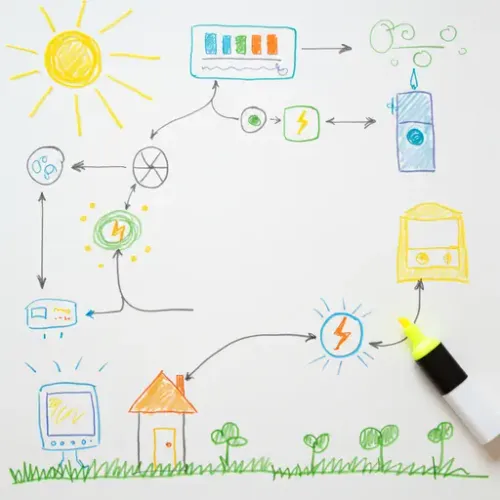Mastering the Home Assistant Energy Dashboard: Saving Watts and Pennies

NGC 224
DIY Smart Home Creator
In the age of rising energy costs and increasing environmental awareness, understanding and controlling your home's energy consumption has never been more important. Home Assistant, already the central hub for countless smart devices, provides a powerful, built-in feature to tackle this challenge: the Energy Dashboard.
What is the Home Assistant Energy Dashboard?
The Energy Dashboard is a dedicated section within Home Assistant designed to collect, visualize, and analyze your home's electricity and gas consumption and production. It offers clear, insightful graphs and statistics that help you see:
- How much energy you're using from the grid.
- How much energy your solar panels (if any) are producing.
- How much energy you're sending back to the grid.
- Your energy usage broken down by individual appliances or areas.
- Historical data to track trends and identify patterns.
- Energy costs based on dynamic pricing or fixed rates.
By making energy usage visible, the dashboard empowers you to make informed decisions about when and how you use electricity, leading to potential savings and a lower carbon footprint.
Prerequisites
To set up the Energy Dashboard, you'll need:
- A running instance of Home Assistant (version 2021.8 or later).
- Devices that can report energy usage (kWh) or power consumption (W). This could be a smart meter integrated via your utility company, a whole-house energy monitor (like Shelly EM, Emporia Vue), smart plugs with energy monitoring, or even individual appliance integrations.
- Basic knowledge of navigating Home Assistant's configuration and Lovelace interface.
Setting Up the Energy Dashboard
The initial setup is straightforward:
- Navigate to Settings > Energy in your Home Assistant sidebar.
- You will be presented with configuration options for different sections: Grid Consumption, Solar Production, Battery Storage, Gas Consumption, and Individual Devices.
Configuring Grid Consumption and Return
This is the most common starting point. You need to add sensor entities that track energy flowing from the grid into your home and potentially to the grid from your home (if you have solar). Home Assistant requires these sensors to have specific attributes to work correctly with the long-term statistics needed for the Energy Dashboard.
- Click 'Add Consumer' under 'Grid Consumption'.
- Select the sensor entity that reports your total energy consumed from the grid (in kWh). This might come from a utility meter integration or a physical energy monitor.
- If you have solar and export energy, click 'Add Producer' under 'Grid Return to Grid'. Select the sensor entity that reports total energy sent back to the grid (in kWh).
Crucial Sensor Requirements: For a sensor to appear in the list for Grid Consumption or Return (and other energy statistics), it must have:
state_class: total_increasingunit_of_measurement: kWh(orMWh,Wh- Home Assistant will handle conversion)device_class: energy
Additionally, for sensors that might reset (like some energy meters after a power outage), they ideally should expose a last_reset or state_attr with the timestamp of the last reset. Home Assistant uses this to calculate usage correctly across resets.
Configuring Solar Production
If you have solar panels, you can integrate their production data:
- Under 'Solar Production', click 'Add Solar Production'.
- Select the sensor entity that reports your total solar energy produced (in kWh). This usually comes from an integration with your solar inverter (e.g., SolarEdge, Fronius, Enphase) or a dedicated solar energy meter.
Crucial Sensor Requirements: Similar to grid sensors, the solar production sensor must have state_class: total_increasing, unit_of_measurement: kWh, and device_class: energy.
Configuring Battery Storage (if applicable)
If you have a home battery system, you can track energy going into and out of it:
- Under 'Battery Storage', click 'Add Battery via'.
- Select the sensor for energy being fed into the battery (in kWh).
- Select the sensor for energy being taken from the battery (in kWh).
Crucial Sensor Requirements: Battery charge/discharge sensors need state_class: total_increasing, unit_of_measurement: kWh, and device_class: energy.
Configuring Gas Consumption (if applicable)
Track your gas usage:
- Under 'Gas Consumption', click 'Add Gas Source'.
- Select the sensor entity that reports your total gas consumed (in m³ or ft³). This requires a gas meter with a pulse counter or a utility integration providing the data.
Crucial Sensor Requirements: Gas sensors need state_class: total_increasing, unit_of_measurement appropriate for gas (e.g., m³, ft³), and device_class: gas.
Configuring Individual Devices (Optional but Recommended)
This is where you can get granular insights into specific appliances:
- Under 'Individual Devices', click '+ ADD DEVICE'.
- Select sensor entities that report energy usage for specific devices (e.g., a smart plug connected to your washing machine).
- You can also add a 'Cost' sensor if you have one configured.
Crucial Sensor Requirements: Device energy sensors need state_class: total_increasing, unit_of_measurement: kWh, and device_class: energy.
Device Integration Tips
Getting Energy Sensors from Power Sensors (W to kWh)
Many smart plugs or devices only report instantaneous power consumption (in Watts, W), not cumulative energy consumption (in kilowatt-hours, kWh). The Energy Dashboard requires kWh sensors.
You can convert a power sensor into an energy sensor using Home Assistant's built-in Integration - Riemann sum helper:
- Go to Settings > Devices & Services.
- Click the Helpers tab.
- Click + Create Helper.
- Search for and select Integration - Riemann sum integral.
- Give it a name (e.g., "Washing Machine Energy").
- Select your instantaneous power sensor (e.g.,
sensor.washing_machine_power) as the 'Input sensor'. - Set 'Unit of measurement' to
kWh. - Keep the 'Unit of time' as
h(hours) and the 'Method' usually defaults to 'Trapezoidal', which is suitable for most purposes. - Click Create.
Home Assistant will create a new sensor (e.g., sensor.washing_machine_energy) that accumulates the power readings over time into a total energy value. This new sensor should automatically have the correct state_class, unit_of_measurement, and device_class to be used in the Energy Dashboard.
Ensuring Correct Sensor Attributes
If your sensor doesn't appear in the Energy Dashboard list, check its attributes in Developer Tools > State. Find your sensor entity (e.g., sensor.my_power_meter_total) and inspect its State attributes. If state_class, unit_of_measurement, or device_class are missing or incorrect, you might need to:
- Update the integration providing the sensor data.
- Use the Home Assistant UI or YAML configuration to customize the sensor attributes (see Home Assistant documentation on 'Customizing Entities'). This is particularly useful for sensors coming from generic integrations like MQTT or REST.
Handling Utility Meter Tariffs
If your electricity price varies throughout the day (time-of-use tariffs), you can configure this in the Energy Dashboard under the Grid Consumption cost section. You'll need a sensor that reflects the current energy price per kWh.
Best Practices for Managing a Reliable Energy Dashboard
Verify Your Data Sources
The Energy Dashboard is only as accurate as the data you feed it. Ensure your energy meters and sensors are reliable and correctly calibrated. Check their readings against your utility bill periodically if possible.
Monitor Long-Term Statistics
Home Assistant stores long-term statistics separately from the default 10-day history. You can inspect these statistics in Developer Tools > Statistics. Look for sensors used in the Energy Dashboard. If you see unexpected spikes, dips, or long periods without updates, it indicates a problem with the source sensor or integration.
Understand and Handle Sensor Resets
Sensors with state_class: total_increasing should ideally only increase. However, some meters might reset to zero (e.g., after a firmware update or power cycle). If a sensor reports a sudden drop, Home Assistant interprets this as negative consumption unless the sensor has a last_reset attribute (or similar) indicating the reset timestamp. Ensure your sensors provide this if they are prone to resetting, or consider using a Helper like the 'Utility Meter' integration in Home Assistant, which is designed to handle periodic resets (like daily, weekly, monthly) and create new accumulating sensors.
Review Configuration Periodically
As you add or remove devices or update Home Assistant, occasionally revisit the Energy Dashboard configuration page (Settings > Energy) to ensure all relevant sensors are still included and correctly configured.
Leverage the Data
Don't just look at the graphs! Use the insights to create automations. For example:
- Run energy-intensive appliances (washing machine, dishwasher) when solar production is high or grid electricity is cheapest.
- Get notified when overall consumption is unusually high.
- Automatically turn off specific devices if consumption exceeds a threshold when no one is home.
Conclusion
The Home Assistant Energy Dashboard is a powerful tool for gaining visibility into your home's energy footprint. By correctly integrating your energy-reporting devices, understanding the required sensor attributes, and following best practices for data reliability, you can build a comprehensive view of your consumption and production. This knowledge is the first step towards optimizing your energy usage, reducing costs, and contributing to a more sustainable future, all managed directly from your central smart home hub.

NGC 224
Author bio: DIY Smart Home Creator
